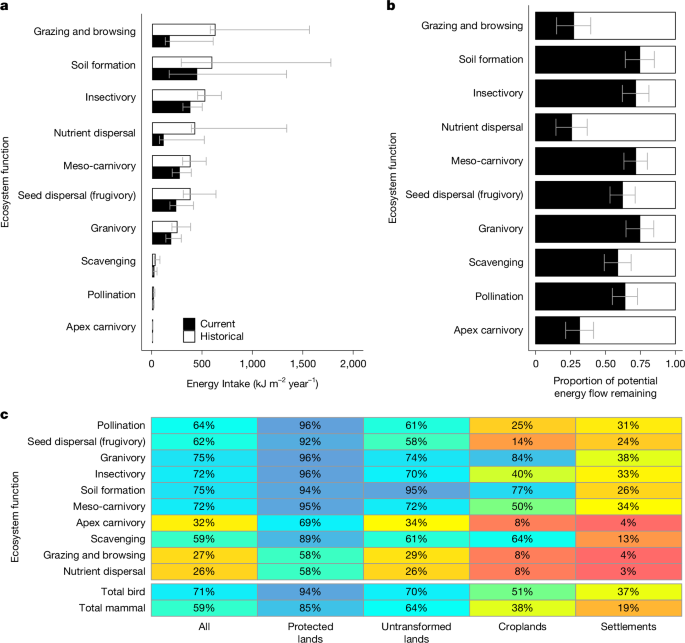Energy flows reveal declining ecosystem functions by animals across Africa
Article Date: 29 October 2025
Article URL: https://www.nature.com/articles/s41586-025-09660-1
Article Image: figure 1
Summary
This Nature paper applies an energetics approach across ~317,000 8 km×8 km cells in sub-Saharan Africa to quantify how energy flows through birds and mammals have changed from pre-industrial (circa 1700 CE) to today. Using modelled species densities, habitat-adjusted ranges and a biodiversity intactness index (BII) compiled from ~30,000 expert estimates, the authors convert species abundances into annual food energy consumption (kJ m−2 yr−1). They group species into trophic guilds and 23 functional groups (10 aggregated functions) and calculate both absolute energy flows and the proportion of historical energy remaining (energetic intactness). The study shows widespread declines in animal-mediated functions, especially those performed by megafauna, with implications for ecosystem resilience, vegetation structure and services such as seed dispersal and nutrient cycling.
Key Points
- Total energy flow through wild African birds and mammals is estimated at ~64% (54–74%) of historical values.
- Energy flow collapses most in intensive land uses: settlements (~27% intact) and croplands (~41% intact); strict protected areas retain ~88% on average.
- Large herbivores (grazers, browsers, frugivores) have lost ~72% of their historical energy flow, driving much of the mammal decline.
- Megafauna-dominated functions (nutrient dispersal, grazing, browsing, apex carnivory) are especially depleted (≈26–32% intact) and are far worse outside protected areas.
- Birds are generally more resilient than mammals; energy share has shifted to smaller species (small birds and mammals now account for ~78% of energy vs 69% historically).
- Biodiversity intactness indices (BIIs) predict total energy flow reasonably for birds but are poor proxies for some functions—especially megafauna-driven ones—so richness/intactness metrics can mask functional loss.
- Some functions persist or even increase locally (avian granivory in croplands), but these can create ecosystem disservices for agriculture.
- The energetics approach offers a common currency (energy) to compare functional changes across taxa, biomes and land uses and to link animal activity to earth-system processes.
Content summary
The authors combined range maps, modelled mean population densities for ~3,000 bird and mammal species, species traits (diet, body mass, lifestyle) and expert-derived BII values to estimate historical and contemporary food-energy consumption per species per grid cell. They translated metabolic needs into annual food intake and aggregated contributions by trophic guild and functional group to calculate energetic intactness (percentage of historical energy flow remaining).
Across biomes (forests, grassy systems, arid systems) energetic intactness has fallen broadly similarly (forest ~65%, grassy ~63%, arid ~69%), but the guilds responsible differ: arboreal species and frugivores drive losses in forests; fossorial mammals and small herbivores matter more in arid systems. Importantly, large herbivores and megafauna functions have declined far more than many bird-dominated functions, and protected areas retain higher energetic intactness for large mammals than surrounding lands.
The study demonstrates that BIIs, which weight species equally, can mislead when functions are dominated by a few high-impact species (for mammals in particular). Energetics reveals that Africa is becoming functionally dominated by smaller, high-metabolic-rate species (rodents, passerines), which do not fully substitute megafauna roles such as long-distance seed and nutrient dispersal or large-scale vegetation modification.
Context and relevance
This work addresses a major gap in large-scale ecosystem assessment: quantifying animal-driven functions beyond vegetation-focused metrics. By using energy as a common unit, the paper connects biodiversity changes to ecosystem processes (herbivory, pollination, seed and nutrient dispersal, soil disturbance) and highlights where functional collapse is most severe. The findings matter for conservation planning, restoration benchmarking (UN Decade on Ecosystem Restoration) and for integrating animal processes into Earth system models and planetary-boundary frameworks.
Practitioners and policymakers should note that conserving species counts or biomass alone may not secure key functions if keystone, high-energy species remain depleted. Restoration should target energetically depleted guilds (for example, arboreal frugivores in forests, megaherbivores across rangelands) and measure success with function-oriented metrics as well as species-level metrics.
Why should I read this?
Short answer: because this paper tells you, in numbers, how animals have stopped doing the heavy lifting for Africa’s ecosystems — and it shows where that matters most. It’s not just another species-count study: it converts population declines into lost energy flows and links those losses to real functions we care about (seed dispersal, grazing, nutrient movement). If you care about restoration targets, how protected areas actually protect function, or about how defaunation rewires landscapes, this saves you time and gives clear diagnostics to act on.
Author note (style)
Punchy take: this is a must-read for conservation scientists and decision-makers. The energetics lens reframes biodiversity loss as functional collapse in a way that’s actionable — it points to which guilds to restore, where to prioritise protection, and why megafauna recovery matters beyond charismatic value. The results are robust at guild and biome scales and should change how large-scale biodiversity assessments are done.

